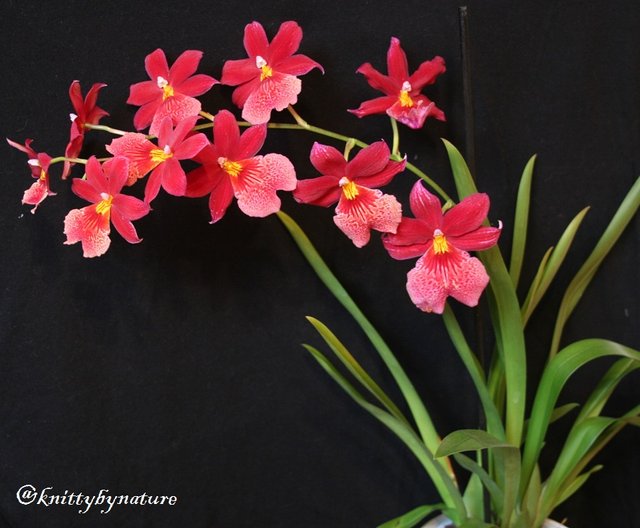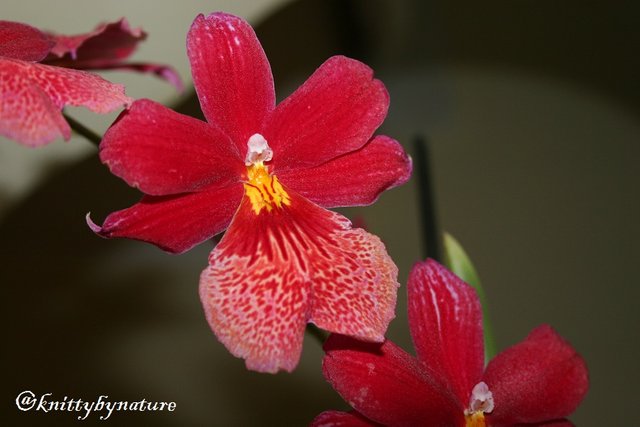Burrageara (Oncidopsis) Nelly Isler: what could go wrong – care tips

Nelly Isler is one of my favorite orchids due to its intensive fragrance and flower' shape and color. Unfortunately, it can be a bit fussy and difficult when grown at home. I have a small confession to make actually: I had made more mistakes than I want to admit when caring for this amazing plant and many of Nelly Islers suffer and died in my care. I have dehydrated my plants and then caused root rots by watering them too much. I burned their roots by fertilizing them too much. I admit I’ve done all of this and many more evil things but now, I think I have finally adjusted my growing conditions and habits to the one which this orchid likes and it rewarded me with this beautiful blooms.

Burr. Nelly Isler, sometimes also labelled as Cambria, is a very beautiful complex hybrid which has oncidium, cochlioda, miltonia and odontoglossum in its parentage. Many of the traits of this orchid’s parentage were transferred to the plant and resulted in a vigorous and spectacular hybrid. The miltonia is reflected in the pantsy-like flowers shape and intensive fragrance, the odontoglossum provided flowers with durability and the glossy leaves are owed to cochlioda and oncidium. This sympodial epiphyte can develop multiple flower spikes at the same time, each of which display up to 10 fragrant flowers. It can bloom during different seasons and more than once a year, whenever a new pseudobulb matures (autumn blooms are most common though). Flowers have a vibrant red color with a white spotted lip and a yellow eye in the middle. Fragrance, which intensifies during the day and fades at night, has scent that resembles citruses with a hint of spices. I do find the scent very pleasant but it can be a bit overwhelming at times.

I do recommend to have Nelly Isler in the orchid family. It is a wonderful plant, despite it being slightly difficult at the beginning, but once you figure out how to care for it, it will reward you with amazing blooms.
Happy growing!!
Suzanah
Burr. Nelly Isler Care Tips
Watering - when medium still moist, use filtered water
Media - sphagnum, fine bark, Seramis® or other more retentive but airy mix
This plant likes moisture around the roots, and hates the medium to go bone dry. If watered irregularly it will develop crinkled leaves, which can damage flower spikes. During long period of droughts its velamen also stops to be viable and roots die. Because of this, a media of larger water retention is better and watering should be done when the media is still slightly moist. The most serious sign of dehydration is wrinkling and shrinking of new pseudobulbs. Humidity trays can also be beneficial to increase air humidity around the plant.
Light - Intermediate light
Burr. Nelly Isler doesn’t like direct sunlight. Too much sun causes yellowing leaves and sunburns. An eastern exposure or shaded western or southern sunlight is ideal.
Temperature - Cool to intermediate
This plant can be grown at temperatures between 10 oC (50 F) at night to 27 oC (80 F) during the day but it grows best in the 15 oC – 22 oC (60 F – 70 F) range. It can withstand higher temperatures for short periods of time but this can cause washed out colour on the lip of a flower.
Fertilizer - 1-2 times a month, any orchid fertilizer Burr. Nelly Isler is not a heavy feeder and can be fertilized 1-2 times a month with a half recommended dosage of fertiliser. The roots have tendency to rot when too much salt accumulates in the pot so it is good to fertilize every other or every third watering to wash the salts away.
Repotting – every 1-2 years (depends on the state of medium) The best time for repotting is when new growth begins to grow. This prevents new root tips to be damaged and allows for faster accommodation to new medium. There is a high chance that the pseudobulbs will become wrinkled after the repot but they should plump up after some time. Burr. Nelly Isler doesn’t like to be divided but if it needs to be it is best to ensure that there are many pseudobulbs in each division. It can be hardly ever propagated through back bulb so it is also good to ensure that each division has a new growth.
All images were done by me.
Some of the information written above were taken from the sources below, some are a result of my trials and errors: http://orchidnature.com/burrageara-oncidopsis-nelly-isler-care-sheet/ http://www.irishorchidsociety.org/burrageara.php
Beautiful flowers.. :)
Thank you!! They are one of my all time favorite. :D